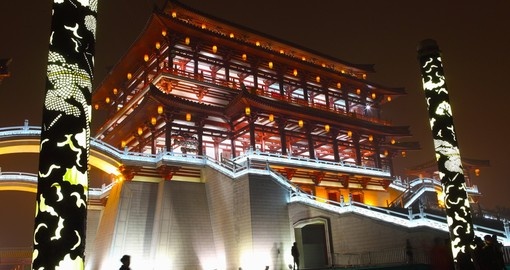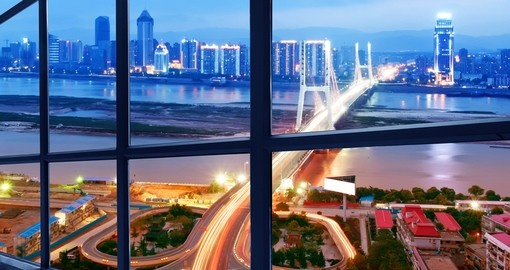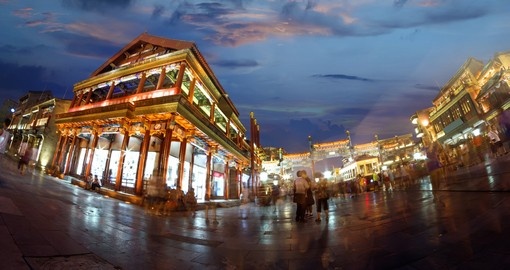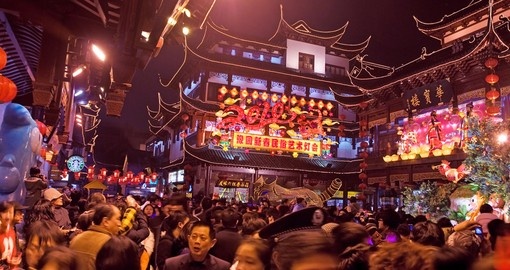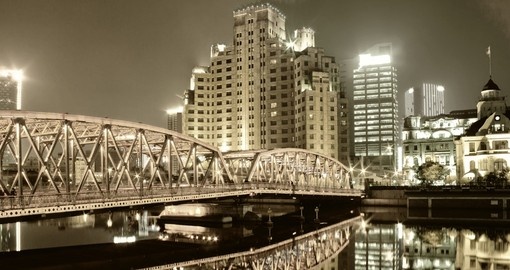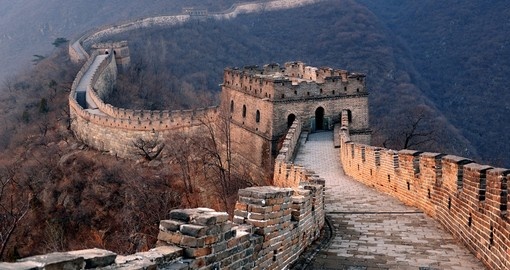China's Main Tourist Attractions
BEIJING
Beijing is located in the North and is China's capital and its most modern city. This bustling city is home to over 21 million people, while remaining steeped in China's rich, royal past. China's two final dynasties (1368-1911) and 26 emperors have bestowed Beijing with the richest dynastic heritage in the world.
The Great Wall of China 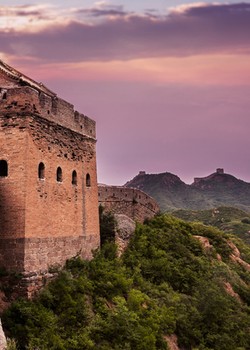
As you first look upon the Great Wall, it is impossible not to be awestruck at this man-made structure. Construction started in the 7th century BC, with additions and rebuilding continuing until the 16th century AD. The Great Wall was built to keep out the warring invaders of the north, but additional sections were extended eastward for nearly 6,700 kilometres. The Badaling section is the most well preserved section of the Wall. You can climb to its top and walk for a mile in either direction: the Great Wall snakes ahead though the mountains as far as you can see.
The Forbidden City (the Palace Museum)
In the heart of the capital lies the Forbidden City, built during the Ming dynasty in 1406. The Forbidden City is actually a city-within-a-city; with 9999 rooms spread over 250 acres. During the Ming and Qing dynasty, 24 emperors made their home in the Forbidden City and forbade commoners from entering. The Emperor's Palace has been transformed into a museum that holds many treasures of the Imperial Family.
Tian An Men Square
Known as the Gate of Heavenly Peace, it is located across the street from the main entrance to the Forbidden City.
The Temple of Heaven
This masterpiece of Ming architecture is one of the most photographed buildings in the world due to its elegant beauty and symmetry. Built in 1420, it was the place where Ming and Qing emperors (Sons of Heaven) prayed to heaven for a good harvest. Music plays softly through the day in a 660-acre park surrounding the temple.
The Summer Palace
Built in 1750, the Palace overlooks tranquil Kunming Lake. There you can stroll along corridors where royal families spent their summers hundreds of years ago.
The Ming Tombs
Large stone animals and human figures line the famous Sacred Way, the entrance to the burial grounds. Set into the hillside is a complex of tombs of 13 emperors from the Ming dynasty.
The Hutongs
A Hutong is an ancient city alley or lane typical of Beijing, where Hutongs run into the several thousand. Surrounding the Forbidden City, many were built during the Yuan (1206-1341), Ming (1368-1628) and Qing (1644-1908) dynasties. In the prime of these dynasties the emperors, in order to establish supreme power for themselves, planned the city and arranged the residential areas according to the etiquette systems of the Zhou Dynasty. The main buildings in the Hutong were almost all quadrangles - a building complex formed by four houses around a quadrangular courtyard. The quadrangles varied in size and design according to the social status of the residents. The big quadrangles of high- ranking officials and wealthy merchants were specially built with roof beams and pillars all beautifully carved and painted, each with a front yard and back yard. However, the ordinary people's quadrangles were simply built with small gates and low houses. Hutongs, in fact, are passageways formed by many closely arranged quadrangles of different sizes. Today, one can enjoy a walking tour of some of the districts which still contain Hutongs.
SHANGHAI
Overlooking the Huangpu River, Shanghai is home to 16 million people and is one of China's largest, most cosmopolitan cities. It is a beautiful city mixing traditional Chinese and 21st century architecture. And at night, the city comes alive with lights which line highways, buildings and the Huangpu River. In the newly built rising Pudong, east of the Huangpu River, it has fast become home to multinational companies with operations in China and Asia.
The Bund
Stretching about a 1.6 km along the Huangpu River, once known as the Wall Street of Asia, China's most famous waterfront is lined with 1930's-era buildings. One of the most elegant and famous of these is the Peace Hotel, recently remodeled. It towers over the harbour and offers wonderful views. The waterfront park along the Bund is a popular meeting place for Chinese and foreign visitors, as well as occasional performers. Early morning visitors will see young and old practicing Tai Chi, martial arts, and ballroom dancing. Side streets in the area have charming 20's and 30's style shops and restaurants.
Nanjing Road
The ultimate shoppers' Mecca and Shanghai's "Fifth Avenue" offers China's greatest variety of retail stores, restaurants, sweets shops, gift boutiques, and cozy night clubs.
Temple of the Jade Buddha
Two of China's most famous jade Buddhas are housed within these temple walls. Each figure is carved from a single piece of white jade, with one carved in a rarely found reclining position.
The Old Town
It is easy to lose yourself in the narrow, winding alleys of Shanghai's Old Town. Stroll through the local bazaar and shop for traditional handicrafts, crossover the pond for lunch and tea in Huxinting Teahouse and then rest in the Garden of the Purple Clouds of Autumn and enjoy its classical Chinese landscaping.
Yu Yuan Gardens
This 16th century garden is a maze of colourful pavilions, ponds, stone dragons, arching trees and flowers, surrounding the instantly recognizable zigzag bridge. It is one of China's finest examples of Ming Dynasty gardens and architecture.
XIAN
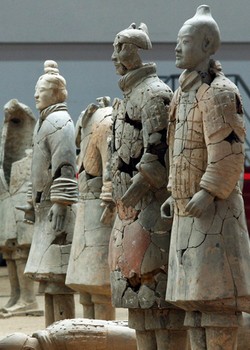 Just one-and-a-half hours by air from Beijing, Xian is the home of the world-famous life-size Terra Cotta Army, unearthed in 1974 after being buried with the first Qin emperor for 22 centuries. Xian was the cradle of ancient Chinese civilization dating back to 4000 BC, and the capital city for 11 dynasties up to the 9th century. It is from here that caravans started on the Silk Road to Europe, changing the Western world forever. The massive City Wall and Moat that surround the city are a monument to the importance of Xian.
Just one-and-a-half hours by air from Beijing, Xian is the home of the world-famous life-size Terra Cotta Army, unearthed in 1974 after being buried with the first Qin emperor for 22 centuries. Xian was the cradle of ancient Chinese civilization dating back to 4000 BC, and the capital city for 11 dynasties up to the 9th century. It is from here that caravans started on the Silk Road to Europe, changing the Western world forever. The massive City Wall and Moat that surround the city are a monument to the importance of Xian.
Museum of the Terra Cotta Warriors and Horses
This is one of the greatest archaeological discoveries in the world with three exhibition halls, the largest of which is 180 metres by 60 metres, housing the continuing excavation of an army of 6,000 life size terra-cotta soldiers and horses that guard the tomb of Qin Shi Huang Di, the first emperor of the unified China. It is a stunning exhibition of ancient artifacts that is well laid out and easy to view.
Shaanxi History Museum
The museum, covering 60,000 square metres, was built in the Tang style of architecture with elegant galleries and courtyards. Its collections amount to over 115,000 relics representing the periods from 11th century BC to 907 AD.
The Xian City Wall
The Xian City Wall is the largest, best-preserved ancient city wall in China.
The Small and Big Wild Goose Pagoda
The Small Wild Goose Pagoda is 43.3 metres high while the Big Wild Goose Pagoda is 64 metres high. They were all built around 700 AD.
GUILIN
Guilin, a cultural city with a history of over 2,000 years, is world famous for its serene landscapes, mysterious limestone formations, mist covered hills and bamboo groves. The region boasts some of the most beautiful scenery in the world, and is one of the most photographed areas of China. The city of Guilin is located on the Li River, surrounded by the exotic geographic formations that seem to evoke a mystical feeling in all who travel here. Although it is a small, slow-paced town, Guilin has a highly developed tourism infrastructure. But it is the breathtaking beauty, peacefulness, and tranquility in such a magical setting that rewards those who visit Guilin. Be sure to bring your camera.
Li River
The Li River, 160 km long, originates on Cat Hill, the main peak of Mount Yuecheng to the north of Guilin. With an elevation of 2141.5 metres, Cat hill is known as the "No.1 Peak in South China". A boat excursion down the Li River from Guilin to Yangshuo following an 83 km long belt of strange landforms, is like travelling along a traditional Chinese painting. You may be also in luck and seeing the ospreys catching fish on the river. Other places of interest include Folded Brocade Hill, Elephant Trunk Hill, Seven-Star Rock and Park and Green Lotus Peak.
Yangshuo
65 km to the southeast of Guilin, Yangshuo is a beautiful mountain city. Surrounded by 18 peaks, the city looks like a lotus flower in full bloom.
GUANGZHOU
Guangzhou is full of reminders of its long and colourful history. Just as the Huai Sheng Mosque, oldest in China, attests to its early international trading in the city, so to the Guangzhou Foreign Trade Centre, which was the venue for the renowned Canton Trade Fair, symbolizes modern commerce. The Shamian Island in the Pearl River, once devoted to foreign concessions and now the setting for the luxurious White Swan Hotel, reminds one of the Opium War.
The mausoleum of the 72 Martyrs commemorates the struggle against the Qing dynasty and the Memorial Garden to the Martyrs of the Canton Uprising is tribute to heroes of the 1927 Revolt. Time permitting, sightseeing includes the early old city of Foshan to visit the 1000 year-old Ancestral Temple and celebrated crafts factories.
SUZHOU
 Suzhou is one of China's oldest cities and also one of its most beautiful. It is a city crisscrossed with a network of canals and subsequently known as the "Venice of the East" with its own Grand Canal. Suzhou also has the most beautiful ornamental gardens in China that combine pavillions, temples and rock sculptures with distinctive arrangements of trees and flowers. The silk Industry is centered in Suzhou and a visit to a silk factory is a rewarding experience.
Suzhou is one of China's oldest cities and also one of its most beautiful. It is a city crisscrossed with a network of canals and subsequently known as the "Venice of the East" with its own Grand Canal. Suzhou also has the most beautiful ornamental gardens in China that combine pavillions, temples and rock sculptures with distinctive arrangements of trees and flowers. The silk Industry is centered in Suzhou and a visit to a silk factory is a rewarding experience.
KUNMING
Kunming is the capital of Yunnan province situated in the very south of China. It has a delightful climate all year round and is encircled by mountains on the north, west and east sides. Being subtropical, it is often termed "The City of Eternal Spring". Twenty two of China's minorities live in the province and add to the charm and colour of this region.
CHENGDU
Situated in the province of Sichuan known for its spicy cuisine, Chengdu has a history of over 2000 years and has managed to preserve the atmosphere of how China might have been sometime in the past. The city is pleasantly laid out with broad streets and many public parks and can be easily explored on foot. The older part of the city has narrow streets lined with scores of small restaurants and two-story brown and white stucco buildings with balconies of sculptured wood. You can eat at one of the many tea houses and cafes. Chengdu is the best place in China to see Pandas. Located just 10 km (6miles) away from Chengdu, the Chengdu Panda Breeding Research Centre imitates the Pandas' natural habitat in order that they might have the best possible environment for rearing and breeding. Giant Pandas, lesser Pandas, black-necked cranes, white storks as well as over 20 species of rare animals are fed and bred there throughout the year. The giant Pandas are a Chinese national treasure. They are found only in Sichuan, Shaanxi and Gansu Provinces. In total there are fewer than 1000, of which 80% are distributed within the territory of Sichuan province.
CHENGDE
Chengde is a 4-hour train journey north of Beijing. It was the summer mountain resort for Emperor Kangxi who lived from 1703 to 1790. Known as the alternative to Lhasa, Tibet, Chengde is well worth a visit and is one of 24 historical cities protected by the Chinese government. One of the major attractions is the Imperial Summer Resort, which covers 5.6 million square metres in area., much larger than the Beijing Summer Palace. You will see the Palace and the Gardens, the latter being extremely beautiful. Another highlight of the city is the Outer Temples which are a mixture of Manchu, Mongolian, Tibetan and Han Chinese architecture, once housing 1000 Buddhist monks but now a museum.
THE SILK ROAD
Used by silk merchants from the second century AD until its decline in the 16th century, the Silk Road is open in parts to tourists eager to explore its heritage. This long string of caravan trails, oases, roads and mountain passes, stretched from northern China, through bleak and foreboding desert and mountainous terrain to the ports on either the Caspian Sea or Mediterranean Sea, and was the conduit for goods and ideas passing between ancient China and the West. The Mongols later used the Silk Road to bind their vast empire, as Marco Polo found when he travelled it in the 13th century.
The two main routes are split into the northern route and the southern route: the northern starting in China at Xian, runs through the Gansu Corridor, Dunhuang, Jade Gate Pass to the neck of the Gobi desert, following the Tianshan mountains round the fringes of the Taklimakan desert to Kashgar and then on to Tashkent (Uzbekistan) and the Caspian Sea. The southern route runs with the northern until the Jade Gate Pass and then stretches round the southern edges of the Taklimakan desert to Kashgar and then over the Karakorum mountain into India.
The Silk Road was a major highway for the spread of Buddhism into East Asia, and later for the growth of Islam, and consequently a number of monasteries, grottos, stupas, minarets and other ruins dating back to the early centuries can still be seen along the way. Other attractions of the route are the diverse scenery, various minority peoples and romantic cities.
Within China the highlights are found in Xinjiang Province, including the Buddhist grottos at Dunhuang, ancient relics at Turpan, such as the ruins of the city of Jiaohe and the lively Sunday market at Kashgar.
YANGTZE RIVER
Coursing a distance of almost 4,000 miles, the mighty Yangtze River is the third-longest river in the world and home to more than 300 million people. To see the power and majesty of China's greatest river aboard a cruise ship is an unforgettable experience. The scenery is breathtakingly beautiful. As the ship passes through deep valleys of lush green hills and narrow canyons with sheer rock cliffs on either side, passengers become lost in a timelessness that has escaped the rest of the world.
A cruise down the Yangtze is an excellent way to see a large area of China in a short time. From spring through fall, dozens of comfortable cruise ships and ferries sail the waters of the Yangtze. Trips are usually taken on cruise ships with luxurious staterooms and fine-dining facilities. Cruises usually dock overnight at towns and villages along the way so that passengers will not miss any of the magnificent scenery. They also allow passengers an opportunity to disembark and explore a small river town for a few hours.
Although there are many cruising options between towns, many travellers opt for the voyage between Chongqing and Wuhan. This cruise is a memorable 850-mile trip that takes 4 days and 3 nights sailing down- stream, or 5 days and 4 nights cruising upstream from Wuhan, passing through the rugged and majestic section of the famous Three Gorges. Visitors often comment that they will never forget its breathtaking beauty. Qutang, Wu, and Xiling Gorges are also popular sections that traverse several narrow and meandering passages, passing mist-laden canyons with an occasional pagoda perched on the side of a cliff with calligraphy carved out of a sheer rock face.
Another scenic side trip takes visitors on a smaller boat through the Three Little Gorges of the Daning River (or Shennongxi Stream), a tributary of the Yangtze. Shore excursions to the ancient towns of Wanxian, Shibaozhai, Fengdu, Yichang, and Jingzhou reveal both the richness of local history and the colorful life along the mighty Yangtze.
TIBET
Lhasa
This Himalayan city (population 600,000), the capital of Tibet, sits at an elevation of 12,000 ft/3,660 m. Visible from almost any point in Lhasa is the Potala Palace. Once the Dalai Lama's winter residence (he has been in exile in India since 1959), it is one of the world's architectural wonders -- the entire building, consisting of thousands of rooms, was created without the use of a single nail. Each of the 70 or so rooms that are open to the public has an atmosphere all its own. (Most are lit only by wicks stuck in yak butter.) The light reflects eerily off the gods, murals, and gold-plated figures. Allow four hours to explore this magnificent building; as with other great museums, it is better not to try to see everything in one day.
A good introduction to Lhasa is the Barkhor Bazaar, where you could spend hours just watching people. In the midst of the bazaar is the fabulous Jokhang, holiest of Tibetan Buddhist temples. It is filled by a steady stream of pilgrims who have come to pay respect to their gods, represented in the temple by an incredible array of devotional art. Be sure to wander around the second floor, and don't be shy about sticking your head into rooms where craftsmen are creating additional gods.
Other sights around Lhasa include Sera and Drepung Monasteries and the Summer Palace. The famed "sky burials" (where corpses are flayed, cut up and fed to the vultures) of Sera have caused increasingly aggressive confrontations between foreign tourists taking photos and domden (undertakers) trying to carry out their religious duties. You really need a strong stomach to observe this "attraction," and most people don't bother with it. Allow three or four days to see Lhasa. (You'll want to do nothing but rest on the first full day.)
Two other locations of interest are Shigatze and Gyantse. Shigatze literally means "fertile land" in Tibetan language. It is the second largest city in Tibet. It is also the official residence of the Panchen Lama who ranks next to the Dalai Lama in Tibet. The city, with a population of 609,228, has been the political, economical and religious center in Southern Tibet.
Gyantse means "peak of success" in Tibetan. With a population of 56,000, it is a small agricultural town and an important post along the ancient Tea and Horse Trading Route between Tibet, China and India. Gyantse is well known for its famous Tibetan Dzong (a fortress or an administrative building located on a hill top), and the monastery called the Pelkor. The local famous specialties are tapestries and wool blankets.
China and Tibet Travel Information
At Goway we believe that a well-informed traveller is a safer traveller. With this in mind, we have compiled an easy to navigate travel information section dedicated to China.
Learn about the history and culture of China, the must-try food and drink, and what to pack in your suitcase. Read about China's nature and wildlife, weather and geography, along with 'Country Quickfacts' compiled by our travel experts. Our globetrotting tips, as well as our visa and health information will help ensure you're properly prepared for a safe and enjoyable trip. The only way you could possibly learn more is by embarking on your journey and discovering China for yourself. Start exploring… book one of our China tours today!
Extend Your Trip
After your China tour consider taking the time to visit other destinations. Goway offers exciting India tours and Thailand vacation packages plus a comprehensive selection of vacation packages in many other Asian countries.
Book your China tour with Goway!
 ASIA by Goway is an exclusive division that specializes in planning and organizing China tours, vacations and experiences. Choose from a simple city stopover, see the country highlights on one of our classic itineraries, enjoy a small group tour, a holiday of a lifetime, a stay of distinction and much more. We want to be your first choice when next you go globetrotting to China.
ASIA by Goway is an exclusive division that specializes in planning and organizing China tours, vacations and experiences. Choose from a simple city stopover, see the country highlights on one of our classic itineraries, enjoy a small group tour, a holiday of a lifetime, a stay of distinction and much more. We want to be your first choice when next you go globetrotting to China.
Get a Trip Quote Order a Brochure







